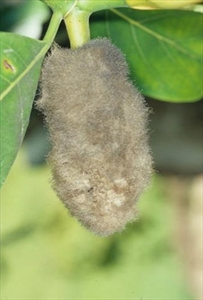Jackfruit Rhizopus fruit rot
Pacific Pests, Pathogens, Weeds & Pesticides - Online edition
Pacific Pests, Pathogens, Weeds & Pesticides
Jackfruit Rhizopus rot (324)
Rhizopus stolonifer; previous names are Mucor stolifer, Rhizopus artocarpi, Rhizopus nigricans.
Worldwide. It is reported from Cook Islands, Fiji, French Polynesia, Niue, Samoa, and Solomon Islands
Jackfruit, and many other plants are hosts. The fungus is common in the soil on plant debris, and also on many fruits (peach, strawberry) and vegetables after harvest, during transport and in storage. In the Pacific islands, Rhizopus has been recorded on sweet potato, breadfruit, passionfruit, citrus (mandarin and tangerine), and eggplant.
Rhizopus rot is a common disease of jackfruit flowers and young fruit. It causes a soft, watery, brown spot on the fruit (Photo 1) that soon becomes covered in a grey-brown, later black, furry mould (Photos 3&4). Fruit symptoms occur on the tree and in storage.
On jackfruit, it is a primary pathogen, affecting the fruits at all stages of development whereas, on most other fruits and vegetables, Rhizopus infects through wounds caused by insects and weather events, or through cracks caused by abnormal growth. Infections also occur at the stem end of fruits when they are harvested.
In the field, warm, rainy days favour the disease, and in storage high temperature and humidy.
Spread is by large number of spores in the air. Survival occurs as thick-walled spores (black spore masses on top of long stalks (Photo 4), in the soil, on plant debris, and on seed. The spores can withstand long periods of drying and cold. Seed infection occurs after damage by insects or rots of the seed head, or fruit.
Probably a minor disease of little economic impact on jackfruit. However, total loss of fruit and vegetables can occur if there are long periods of warm, rainy weather. In storage, damage is likely if hygiene is poor, and temperature and humidity are high.
Look for the soft, rapidly development fruit rots on the tree or in storage. Look for the grey fungal growth, turning black as the spores develop.
In most instances, management will not be required as the impact of the disease is low. If environmental conditions are such that they favour the disease, do the following:
CULTURAL CONTROL
During growth:
- Prune the trees so that air travels freely through the canopy and the fruit dries rapidly after rains.
- Carry out hygiene measures: remove infected fruits of all ages from the trees and any that have fallen to the ground.
After harvest:
- Harvest fruit with care, avoiding bruising it or creating wounds. Similarly, transport the fruit with care.
- Avoid storing fruit in warm, poorly ventilated, buildings with high humidity; if possible, store the fruit below 10°C. Rhizopus does not produce spores at 4°C. Remember, one fruit in a consignment can cause the rot of many others in a few days.
- Make sure the packing shed and boxes/bins are clean, removing any plant material on which Rhizopus could produce spores.
CHEMICAL CONTROL
If fungicides are required, apply a protectant product, e.g., mancozeb, or a systemic benzimidazole, e.g., thiophanate-methyl or a triazole, e.g., propiconazole. If a systemic product is used, alternate these with sprays of mancozeb. If the concern is only to protect the fruit in storage, spray once 10 days before harvest.
____________________
When using a pesticide, always wear protective clothing and follow the instructions on the product label, such as dosage, timing of application, and pre-harvest interval. Recommendations will vary with the crop and system of cultivation. Expert advice on the most appropriate herbicides to use should always be sought from local agricultural authorities.
AUTHORS Grahame Jackson & Eric McKenzie
Information from Soft rot of Jackfruit (undated) Plantwide Knowledge Bank. (https://www.plantwise.org/KnowledgeBank/factsheetforfarmers/20157800446); and Trakunsukharat P, et al. (2011) Rhizopus rot (Rhizopus stolonifer): PaDIL - http://www.padil.gov.au; and from (including Photos 1,2&4) McKenzie E (2013) (Rhizopus stolonifer): PaDIL - (http://www.padil.gov.au). Photo 3 Ellen Iramu, Honiara, Solomon Islands.
Produced with support from the Australian Centre for International Agricultural Research under project PC/2010/090: Strengthening integrated crop management research in the Pacific Islands in support of sustainable intensification of high-value crop production, implemented by the University of Queensland and the Secretariat of the Pacific Community.







